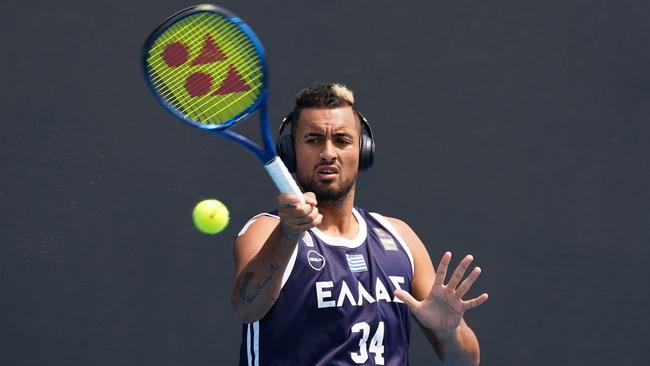Australian Open field wary of mercurial man Nick Kyrgios
Grigor Dimitrov knows how dangerous – and unpredictable – Nick Kyrgios can be on a tennis court.

As with virtually everybody else in the global tennis community, Grigor Dimitrov is aware of Nick Kyrgios’s humanitarian passion.
Impressed with the polarising Australian’s often anonymous charity work, Dimitrov also knows how dangerous – and unpredictable – Kyrgios can be on a tennis court.
A 2017 Melbourne Park semi-finalist, Dimitrov came off second best in a Kooyong Classic encounter last week.
It was a reminder — albeit in two exhibition sets — of Kyrgios’ capabilities as the Canberran prepares to start his seventh Australian Open campaign against Italian Lorenzo Sonego.
“You know anything can happen, but you’ve got to expect that right?” Dimitrov said of Kyrgios.
“Clearly he’s serving unbelievable at the moment, I think that’s gonna help him a lot at the Australian Open.
“This is close to the best I’ve seen him play right now. The guy is probably one of the talented guys out there.
“He’s got a huge serve. He can use it at any time in a match. You never underestimate a guy like that. He’s got everything to win any tournament. The rest is up to him. You need to win seven matches, three sets every match. Once you enter that second week, anything can happen.”
Kyrgios, whose best Melbourne Park harvest was a run to the fourth round two years ago, admits his focus has strayed from tennis as he concentrated on driving fundraisers for bushfire relief causes.
But, on match day, he expects competitive instincts to sharpen.
“Sonego is a tough competitor. I played him in Cincinnati last year,” Kyrgios said.
“It was a tough match. Very capable player. Big serve. Loves to hit his forehand.”
Kyrgios could play world No 1 Rafael Nadal in the fourth round – an ambitious assumption, according to the 23rd seed.
“I’m not looking forward at all. Everyone can play,” he said.
“All these guys can produce tennis on the day. I’m not even going to think about throughout the draw right now.”
In day one action, Canadian Denis Shapovalov angrily accused a chair umpire of making a “terrible call” after becoming the first big casualty at the Australian Open.
The world No 13 seed was ousted by Hungarian Marton Fucsovics in four sets, despite heading into the first-round clash as an unbackable $1.15 favourite with TAB.
In the third set he received a code violation for racquet abuse, which led to a heated on-court row with French umpire Renaud Lichtenstein.
He was coded for repeatedly throwing his racquet, despite the fact that it was not damaged and he played on with it. “I think that was a terrible call from the ref,” Shapovalov said after his defeat.
“The rule from what I know is if I break my racquet you can code me, but you can’t code me for slamming it.
“I’m not doing anything, it didn’t impact anyone.
“The racquet was still intact, so he gave me a warning because I did it two or three times and I think that’s not the way it works.”
The Canadian said it was not fair he would receive a fine and there would be no repercussions for the umpire.
“I think it’s horrible, I’m going to get fined for whatever the code was and he gets off the hook because he just makes a call because he feels like it,” he said.
“I threw my racquet, but so what?”
Shapovalov admitted he struggled with nerves in his shock defeat.
“I think I played really nervous today,” he said.
“I was in really good shape going into the tournament, but I just played really tight today.”
Fucsovics described the Australian Open as his “favourite grand slam” after winning through to the second round.
The 27-year-old Hungarian made the fourth round two years ago.
“I played some of my best tennis today,” he said
“I was aggressive when I needed to be here and hit the ball well.”
Meanwhile, Borna Coric (No 25) became the first seeded player to be knocked out, losing in straight sets to Sam Querrey.
HERALD SUN



To join the conversation, please log in. Don't have an account? Register
Join the conversation, you are commenting as Logout